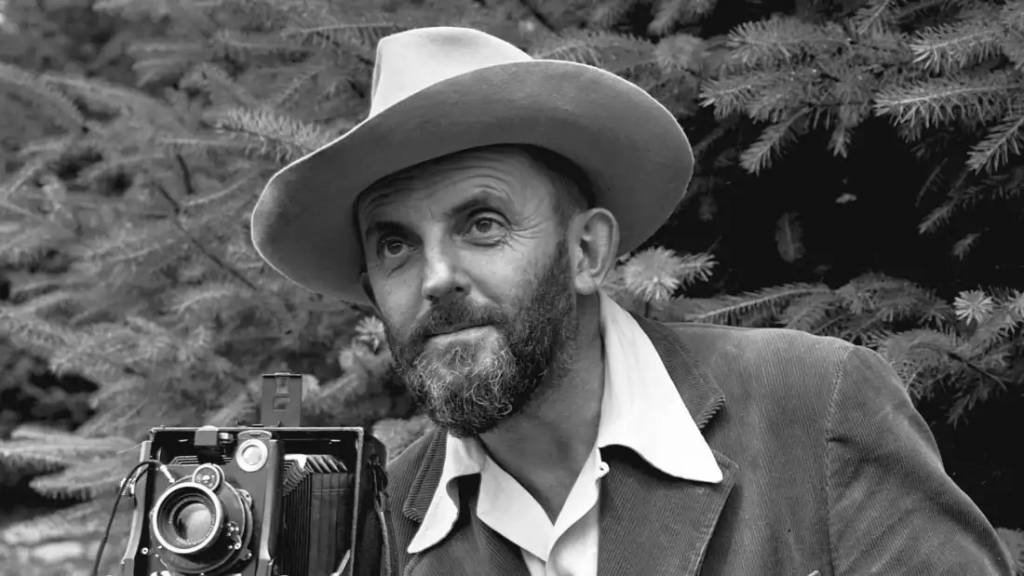Ansel Adams is a familiar name to people both in and outside the art world. His photographs of the American West are squarely ingrained in popular imagination and are rightfully praised for their incredible beauty.
This reverence for Adams extends into his technical contributions as well. His development of the Zone System, a way of incorporating a full range of light and dark into a photograph, revolutionized how photographers picture the world around them. This technical expertise extended into the darkroom and eventually onto the pages of manuals that remain critical photography texts today.
It was this marriage of technical prowess and artistic vision that yielded Adams’ most recognizable images. Visitors that come to our newest temporary exhibition Ansel Adams in Our Time, opening September 19, may be eager to see Monolith or Moon and Half Dome. They will not be disappointed. However, the show also incorporates a broader range of his production.

Moon and Half Dome, Yosemite National Park, Ansel Adams (American, 1902–1984), 1960, Photograph, gelatin silver print, 2018.2681, Museum of Fine Arts, Boston. The Lane Collection, © The Ansel Adams Publishing Rights Trust, Courtesy, Museum of Fine Arts, Boston
Humans and Landscapes
Included among these works are photographs from important nineteenth-century photographers like Eadweard Muybridge and Carleton Watkins, but also extends to our present day with the works of 24 contemporary artists, whose photographs carry the unmistakable influence of Adams. Among roughly 180 objects, Ansel Adams remains the backbone of the exhibition, but the inclusion of his predecessors and successors helps set his practice into perspective.
These works focus on the people living in these places, the impact of humans on the landscape, and capturing what he viewed as a timeless beauty evidenced in the sprawl of sky and sand. This broad range of subject matter, in addition to his early experiments with Modernist techniques, and later photographs of cities, all factor into the more than 100 Adams photographs that comprise this exhibition.
In Our Time
But with such an expansive catalog of creations, why endeavor to place Adams, with this show, in our time? At Crystal Bridges, we often talk about the continued relevance of history. Taking a look at a recognizable titan of photography in the current moment helps us examine his legacy and his contributions. Opinions and an artist’s impact can ebb and flow over time, so taking a moment to reassess an icon like Ansel Adams “in our time” is critical.
Spoiler alert: his work holds up. You’ll still get lost in the rich range of light and dark and the majestic views of recognizable places. But what’s exciting about a show like this is the way our relationship with these vistas evolves. In some instances, Adams anticipated concerns that on the surface seem decidedly contemporary. A section of the show looks at his photographs of human impact on the land he sought to preserve. His images of urban sprawl and burned forests anticipate the contemporary works by artists like Mitch Epstein and Laura McPhee.

Tent-Camera Image on Ground: View of Mount Moran and the Snake River from Oxbow Bend, Grand Teton National Park, Wyoming, Abelardo Morell (American (born in Cuba, 1948)), 2011, Photograph, inkjet print, Abelardo Morell │Courtesy of Edwynn Houk Gallery, Courtesy, Museum of Fine Arts, Boston
Even among his most recognizable photographs of national parks, the conversations in 2020 both echo and diverge from Adams. For numerous Americans, national parks still embody an Adams-esque retreat from the everyday. However, these images renew questions about who feels comfortable escaping to national parks and also brings up enduring histories about who is responsible for protecting this land. Contemporary photographers like Binh Danh and Abelardo Morell broach topics of belonging and land claims with tremendous reverence for Adams and also a critical eye toward the now.
***
With the benefit of hindsight, we can understand how Adams was simultaneously an amazing innovator and champion of nature, but also a product of his time, which occasionally yielded blind spots. I bring this up not to bash on a beloved figure from art history. I do it to emphasize that Adams’ contributions and perspectives remain incredibly valuable. His work continues to move viewers and stimulate conversation. The conversations shift with time, of course, but a tell-tale sign of important art is its continued ability to straddle being both timeless and relevant now.
But I digress – come to Crystal Bridges and make that call for yourself.
Written by Alejo Benedetti, associate curator, contemporary art, and in-house curator of Ansel Adams in Our Time at Crystal Bridges.
Exhibition organized by

Cover photo of Ansel Adams by J. Malcolm Greany.




